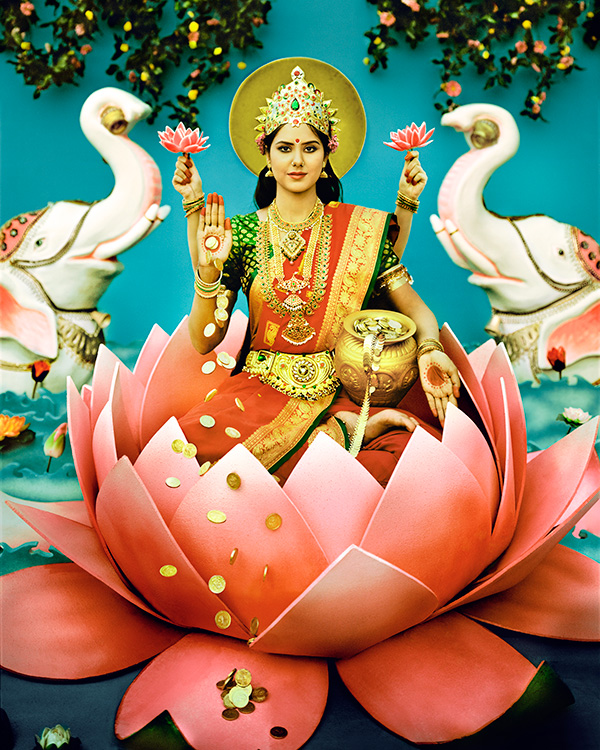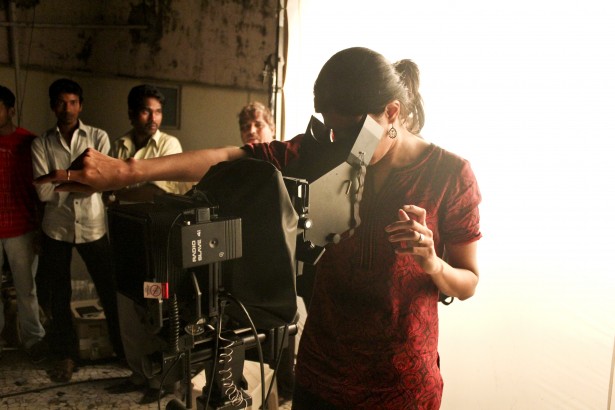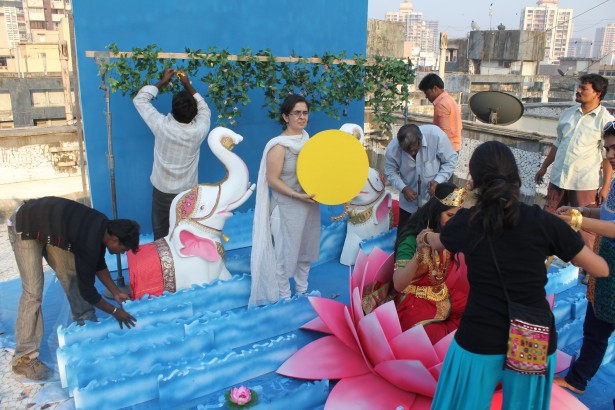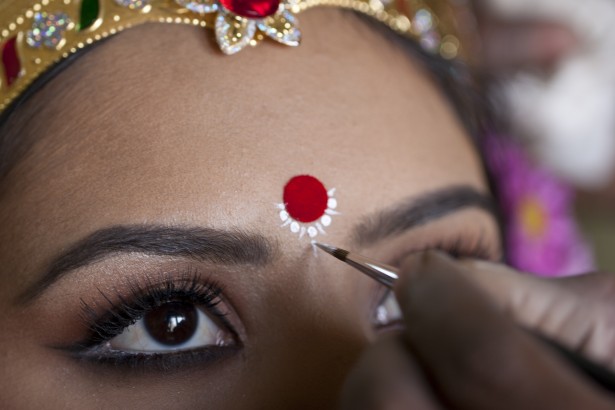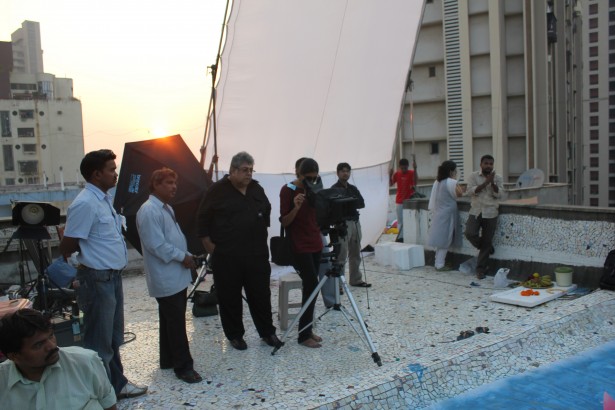Q&A: Manjari Sharma
By Rafael Soldi
Manjari Sharma (b. 1979) is an internationally published photo-based artist born and raised in Mumbai, India and based in Brooklyn, New York. Manjari’s artwork is rooted in the study of relationships, personal mythology and experience. Amongst being in various private collections, Manjari’s work can be found in the permanent collection of Museum of Fine Arts, Houston and has been showcased in group and solo shows both in the United States and worldwide.
Manjari was awarded The CENTER's Curator's Choice award, 2014 and her work was selected as Honorable Mention for the Santa Fe Prize in 2012. Manjari holds a bachelors degree in Visual Communication from S.N.D.T University, Mumbai and a Bachelor of Fine Arts in Still Photography from Columbus College of Art and Design in Columbus, Ohio. Manjari is represented by ClampArt Gallery in New York City and Richard Levy Gallery in New Mexico.
Rafael Soldi: Your most successful and prolific body of work so far has been your shower portraits. This new project, Darshan, is very different. I’m curious about your subject transition, from photographing nude subjects in the shower to creating classical images of Hindu gods and goddesses. As one of the subjects in your shower series myself, we engaged in a conversation about the sexual/intimate nature of the experience and the implications your cultural upbringing brought along. Can you elaborate on your subject transition? How do you balance the act of literally showering with you subject as opposed to making images of your sacred gods? Do they inform one another in any way?
Manjari Sharma: Great question Rafael. in fact in a recent conversation with a subject for the Shower Series, we discussed how spirituality and sexuality are both sides of the same coin. People want to be sexual and they want to be spiritual and the process of understanding both takes time! What I learned in the shower was about the power of human connection and how our fragility is one of the most beautiful things that connects us as people. Nudity was a part of the process in the shower series, but not the spotlight. Yet the sexual nature of the subject matter could not be ignored. My project Darshan aims to photographically recreate 9 classical images of gods and goddesses pivotal to mythological stories in Hinduism. For me Darshan is the culmination of photography and spirituality, both topics have been objects of my devotion life long. Looking at a series comprising of classical images of HIndu deities may make people wonder if it’s a project touting religion, and while that cannot be ignored, it’s again not the spotlight. This project is about a sense of human connection. My subjects in the images appear to be gods and goddesses, bearing strong resemblance to the iconography of Indian culture we are used to seeing. Yet they are real people like you and me. Unreal moments can be fashioned out of concrete reality and that is one of my favorite challenges and wonder of using photography.
In a sense, a place like the shower, a place of everyday practical use could transport us into a spiritual experience. Similarly in Darshan we learn that a seemingly extraordinary and unreal sight that feels other worldly is a constructed set fashioned of very concrete elements. In India we say “Namaste” as a common greeting to each other and it comprises of holding your hands together at your chest and bowing down in respect; It’s especially done when you stand before a deity in a temple. Namaste quite literally means, the spirit in me respects the spirit in you. If we feel a sense of bowing down to a God or Goddess in an image from the Darshan series, we are ultimately bowing respect to the spirit of another human being looking back at us, which gives takes Namaste to a whole different level for me. In all my series, be it the Shower, Darshan or even Anastasia context is a common string.
RS: Darshan is a real production, a huge endeavor. Tell us more about your workflow and process as you create these images.
MS: I take the time to plan my lines, my colors, perspective and proportions and aim to create the image with as much explicit detail as possible. It is my aim to create from scratch everything required to make the images in this series. In order to create the image of Maa Laxmi for example, the research came first. All aspects had to be studied – from wardrobe to significance. With measuring tapes all over the set, we studied and tried to understand vanishing points which can be fluidly controlled in painting but needs to planned carefully alongside symmetry in the photo. Let’s not forget we were shooting film, 4×5 to be specific! In order to create the final results, A diverse crew of 14 people came together: it included set & prop builders, makeup artists, art directors, painters, carpenters, jewelry experts and assistants. All of these people that you can see on the video were handpicked from their respective areas of expertise. The model you are looking at was also very carefully chosen after many auditions. Maa Laxmi’s expression in the photograph is one that had to be very intently studied in order to emulate. The whole production was time intensive and required meticulous attention because for me the sense of spirituality was heavily contingent on the authenticity and detail in the image.
RS: Where will you be working when you produce this work? How important is it for you to involve members of your own culture/community in creating the imagery?
MS: The project is being photographed in Mumbai, India where I was born and raised. This project needs to be shot in India for many reasons, but one of the main ones is that everyone in the crew is from the culture. All team members are very familiar with the subject matter and have a great deal of respect for what they are working on. Many turned out to be ardent devotees of one God or another. The girl who played the character of Maa Laxmi is herself a big devotee of Maa Laxmi. All of the energy of the crew combined with the fact that I am in the birthplace of the tradition does make a huge difference to the project.
My family is very spiritual and my parents exposed me to Hinduism, its teaching and artifacts from a very early age. Visiting countless Indian temples frequently was common practice to us. So at a more personal level, my parent’s involvement has also greatly influenced the project. Having perspective that if you have faith, you will receive the grace you need to complete something of this stature is a really important mantra to remember when you take on a subject of this magnitude. My parents do a fantastic job of reminding me of the humility a project like this needs.
RS: What is your vision for this project?
MS: Darshan is a Sanskrit word that means ‘sight,’ ‘view’ or ‘vision’. I want the final show to be a “Darshan” of this series to the world at large.
I see the whole project displayed as an installation of 6 feet tall prints. Once complete, I see the exhibit designed to evoke the experience of a Hindu temple in Museum. Just as in a temple, the images will be lit up and cordoned off from the viewer. The route to their Darshan will be delineated such, that the seeker will be guided from image to image taking in a unified experience which will aim to be memorable by engaging all senses. Audience wise, I want people who are appreciators of both art and/or religion; Curious souls and seekers who are intrigued but have have maybe never experienced the culture first hand to see the show. I want people who may otherwise not enter a Hindu temple to maybe go into a museum and get to study these images and the experience from just an artistic and or a cultural standpoint; But without the baggage that a house of worship or religion comes with. Similarly I want maybe a spiritual or religious HIndu to be able to experience the deities outside of a Hindu temple and be able to re-live the same experience out of context. At a larger level, Darshan has now became a cultural calling for me to preserve my heritage by using the medium of photography.
Editor's note: this interview was originally published on August 23, 2011 on the PCNW blog.
UPDATE
October, 2015
MS: Since August 2011 which is when we last spoke about the work, eight more deities in the series were created by April 2013. I've attached a thumbnail of a very early illustrator sketch of how I pre-visualized all nine photographs in the series in terms of their broad color palette. The behind the scenes process of creating these works continued to become more complex and detail oriented and was captured in little haiku videos by sicilian film maker Roberto Farruggio: http://manjarisharma.com/darshan#/id/v91018.
Darshan debuted as a solo show in 2013 at ClampArt gallery in New York City and has since traveled to Levy Gallery, New Mexico in Spring 2014 and then was invited be a part of a three-person show at Asia Society, Houston Texas in Fall 2014. At AsiaSociety's museum the work was displayed as nine six foot installations and that truly allowed for the work to be presented in with he breathing room it deserved (images attached). In the last year the work has been juried in international group shows and photo festivals in Chicago, Lieden, Goa, Croatia, Delhi and will soon be traveling to Photo festival in China. In 2014 a piece from Darshan got acquired by curator Ann Tucker for the Museum of Fine Arts, Houston permanent collection. 2015 has mainly been the year to hunker down and work on some new projects that are still growing in volume, form and function.
First image © Manjari Sharma
Subsequent images © Ashish Gurbani and Dilnaaz Mehta

